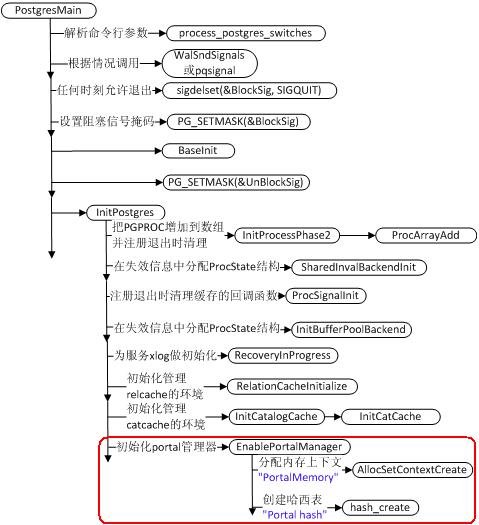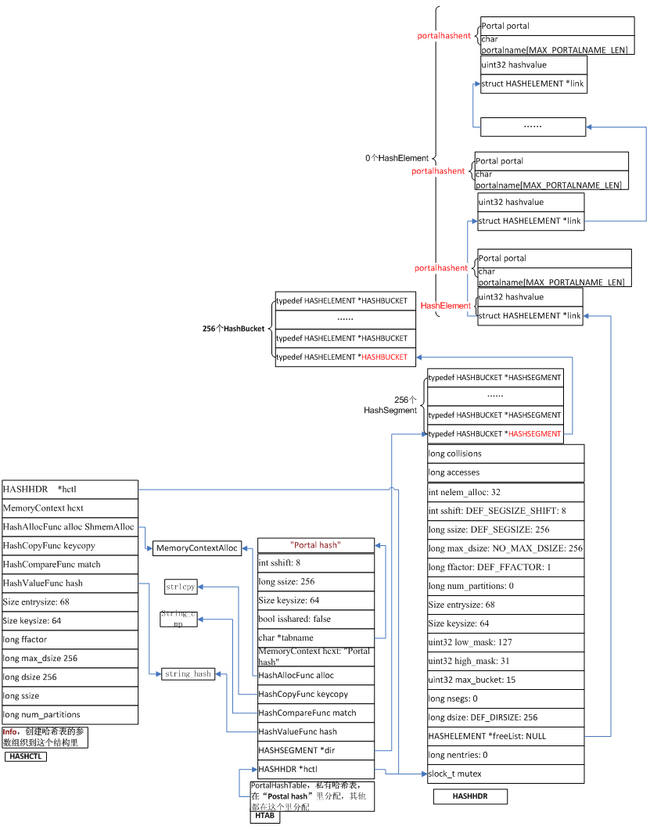PostgreSQL服务过程中的那些事一:启动postgres服务进程一.七:初始化portal管理环境
话说调用 InitPostgres 方法给 portgres 服务进程做相关初始化,这个方法里初始化了 relcache 和 catcache ,初始化了执行查询计划的 portal 的管理器,填充本进程 PGPROC 结构相关部分成员等,上一节讨论了 relcache 管理环境的初始化,这一节继续讨论执行 sql 的 portal 管理器的初始化。
1
先看 InitPostgres 方法的调用序列梗概图
InitPostgres方法的调用序列梗概图
InitPostgres方法为初始化这个postgres服务进程做了一系列的工作,具体如下:
(1)调用InitProcessPhas e2 方 法,把本进程的PGPROC结构注册到PGPROC数组,就是让共享内存里的PGPROC数组(初始化PGPROC数组的文章见《PostgreSQL启 动过程中的那些事七:初始化共享内存和信号十一:shmem中初始化SharedProcArray》)的第一个空元素指向这个PGPROC结构,并注册 退出时做内存清理的函数。
(2)调用SharedInvalBackendInit 方法,在该后台进程数据的共享失效管理器数组获取一个ProcState结构(相关数据结果见《PostgreSQL启动过程中的那些事七:初始化共享内 存和信号十三:shmem中初始化SharedInvalidationState》)给该进程并初始化相关项,并注册退出方法以在退出时标记本进程的项 非活跃。
(3)调用 ProcSignalInit 方法, 在 ProcSignalSlot 结构 数组(关于 ProcSignalSlot 结构 数组参见《PostgreSQL启动过程中的那些事七:初始化共享内存和信号十四:shmem中初始化PMSignal》) ProcSignalSlot s 里给当前进程获取一个元素,元素下标是MyBackendId-1,并注册以在进程退出时释放这个槽。
(4)为访问XLOG,调用RecoveryInProgress方法做共享内存相关初始化。
(5)调用RelationCacheInitlisze 方法做管理relcache的环境的初始化。
(6)调用InitCatalogCache方法做管理catcache的环境的初始化。
(7)调用EnablePortalManager方法初始化portal管理器。
(8)调用RelationCacheInitializePhase2方法初始化共享系统表。
(9)调用 GetTransactionSnapshot 方法获取一个事务快照。这个方法在后面讨论简单查询时再讨论。
( 10 )调用 PerformAuthentication 方法根据 hba 文件设置进行客户端认证。
( 11 )调用 GetDatabaseTuple 方法根据数据库名字从 pg_database 系统表获取要访问的数据库对应的元组。
( 12 )调用 RelationCacheInitializePhase3 方法完成 relcache 初始化。
( 13 )调用 CheckMyDatabase 方法检查当前用户的数据库访问权限,从 cache 里的 pg_database 取当前数据库的相关属性字段。
( 14 )调用 InitializeClientEncoding 方法初始化客户端字符编码。
( 15 )调用 pgstat_bestart 方法在 PgBackendStatus 设置本进程状态。
2
下面讨论第( 7 )步, EnablePortalManager 方法初始化 portal 的管理环境。 portal 表示一个正在运行或可运行 query 的执行状态的抽象,具体情况到后续《 pg 服务过程中的那些事二》讨论 pg 处理简单查询时再具体讨论。 EnablePortalManager 方法先调用 AllocSetContextCreate 方法创建内存上下文 "PortalMemory" ,然后调用 hash_create 在这个内存上下文里创建 哈西表 "Portal hash" 。“ EnablePortalManager 调用序列图”见下面,为了图能大一点, PostgresMain 以前的调用流程序列就从下面的图中省略了,要回顾可以参考上面的“ InitPostgres 方法的调用序列梗概图 ”。
EnablePortalManager 调用序列图
Portal 是指向 PortalData 结构的指针类型。相关定义和结构图见下面。
typedef struct PortalData * Portal ;
typedef struct PortalData
{
/* Bookkeeping data */
const char * name ; /* portal's name */
const char * prepStmtName ; /* source prepared statement (NULL if none) */
MemoryContext heap ; /* subsidiary memory for portal */
ResourceOwner resowner ; /* resources owned by portal */
void (* cleanup ) ( Portal portal); /* cleanup hook */
SubTransactionId createSubid ; /* the ID of the creating subxact */
/*
* if createSubid is InvalidSubTransactionId, the portal is held over from
* a previous transaction
*/
/* The query or queries the portal will execute */
const char * sourceText ; /* text of query (as of 8.4, never NULL) */
const char * commandTag ; /* command tag for original query */
List * stmts ; /* PlannedStmts and/or utility statements */
CachedPlan * cplan ; /* CachedPlan, if stmts are from one */
ParamListInfo portalParams ; /* params to pass to query */
/* Features/options */
PortalStrategy strategy ; /* see above */
int cursorOptions ; /* DECLARE CURSOR option bits */
/* Status data */
PortalStatus status ; /* see above */
bool portalPinned ; /* a pinned portal can't be dropped */
/* If not NULL, Executor is active; call ExecutorEnd eventually: */
QueryDesc * queryDesc ; /* info needed for executor invocation */
/* If portal returns tuples, this is their tupdesc : */
TupleDesc tupDesc ; /* descriptor for result tuples */
/* and these are the format codes to use for the columns: */
int16 * formats ; /* a format code for each column */
/*
* Where we store tuples for a held cursor or a PORTAL_ONE_RETURNING or
* PORTAL_UTIL_SELECT query. (A cursor held past the end of its
* transaction no longer has any active executor state.)
*/
Tuplestorestate * holdStore ; /* store for holdable cursors */
MemoryContext holdContext ; /* memory containing holdStore */
/*
* atStart, atEnd and portalPos indicate the current cursor position.
* portalPos is zero before the first row, N after fetching N'th row of
* query. After we run off the end, portalPos = # of rows in query, and
* atEnd is true. If portalPos overflows, set posOverflow (this causes us
* to stop relying on its value for navigation). Note that atStart
* implies portalPos == 0, but not the reverse (portalPos could have
* overflowed).
*/
bool atStart ;
bool atEnd ;
bool posOverflow ;
long portalPos ;
/* Presentation data, primarily used by the pg_cursors system view */
TimestampTz creation_time ; /* time at which this portal was defined */
bool visible ; /* include this portal in pg_cursors? */
} PortalData ;
#define NAMEDATALEN 64
#define MAX_PORTALNAME_LEN NAMEDATALEN
typedef struct portalhashent
{
char portalname [MAX_PORTALNAME_LEN ];
Portal portal ;
} PortalHashEnt ;
static HTAB *PortalHashTable = NULL;
管理 portal 的 PostalHashTable
------------
转载请著明出处,来自博客:
blog.csdn.net/beiigang
beigang.iteye.com


